
Polo is a ball game that is played on horseback, a traditional field sport and one of the world's oldest known team sports. The game is played by two opposing teams with the objective of scoring using a long-handled wooden mallet to hit a small hard ball through the opposing team's goal. Each team has four mounted riders, and the game usually lasts one to two hours, divided into periods called chukkas or chukkers.

Buzkashi is the national sport of Afghanistan and Tajikistan. It is a traditional sport in which horse-mounted players attempt to place a goat or calf carcass in a goal. Similar games are known as kokpar, kupkari, and ulak tartysh in Kyrgyzstan and Kazakhstan.

The yak, also known as the Tartary ox, grunting ox, or hairy cattle, is a species of long-haired domesticated cattle found throughout the Himalayan region of Gilgit-Baltistan, Nepal, Sikkim (India), the Tibetan Plateau, (China), Tajikistan and as far north as Mongolia and Siberia. It is descended from the wild yak.
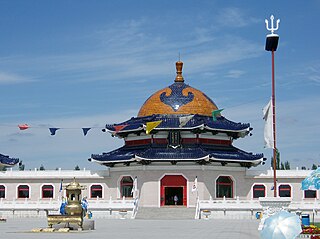
The Mausoleum of Genghis Khan is a mausoleum dedicated to Genghis Khan, where he is worshipped as ancestor, dynastic founder, and deity. The mausoleum is better called the Lord's Enclosure, the traditional name among the Mongols, as it has never truly contained the Khan's body. It is the main centre of the worship of Genghis Khan, a growing practice in the Mongolian shamanism of both Inner Mongolia, where the mausoleum is located, and Mongolia.

Baltistan also known as Baltiyul or Little Tibet, is a mountainous region in the Pakistani-administered territory of Gilgit-Baltistan and constitutes an northern portion of the larger Kashmir region that has been the subject of a dispute between India and Pakistan since 1947. It is located near the Karakoram and borders Gilgit to the west, China's Xinjiang to the north, Indian-administered Ladakh to the southeast, and the Indian-administered Kashmir Valley to the southwest. The average altitude of the region is over 3,350 metres (10,990 ft). Baltistan is largely administered under the Baltistan Division.

Khövsgöl is the northernmost of the 21 aimags (provinces) of Mongolia. The name is derived from Lake Khövsgöl.

The argali, also known as the mountain sheep, is a wild sheep that roams the highlands of western East Asia, the Himalayas, Tibet, and the Altai Mountains.
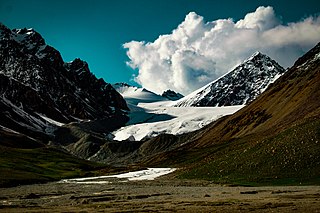
Khunjerab National Park is a national park in Gilgit Baltistan, Pakistan. Khunjerab National Park is Pakistan's third largest national park, and is adjacent to the Taxkorgan Natural Reserve in China.
Sport in Pakistan is a significant part of Pakistani culture. Cricket is the most popular sport in Pakistan. Football has also gained popularity in recent years, and is the second most popular sport in the country. Field hockey is the national sport, and was popular for several decades, with some of Pakistan's greatest sporting accomplishments having taken place in this sport, along with squash. Polo and traditional sports like kabaddi and other well-known games are also played.
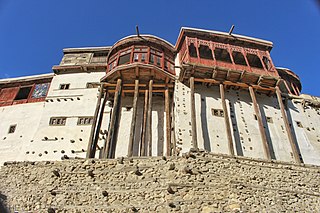
Karimabad, formerly known as Baltit, is the capital of the Hunza District in Pakistan-administered Gilgit-Baltistan in the disputed Kashmir region.
Yak skiing is a sport practiced in the Indian hill resort of Manali, Himachal Pradesh, as a tourist attraction. The sport involves a skier waiting at the bottom of a slope and a yak at the top of the hill; yak and skier are connected by means of a rope going around a pulley at the top of the hill. To engage the yak, the skier must shake a bucket of pony nuts. This attracts the yak, which charges downhill and pulls the skier upward by means of the rope.

Shigar is the headquarter of its namesake district and tehsil in the Baltistan division of Gilgit-Baltistan region in northern Pakistan. It is located on the bank of the Shigar River in the most remote part of the region. It is a popular site for tourists and trekkers and contains many historical buildings of architectural significance associated with several different communities.

Gorkhi-Terelj National Park is one of the national parks of Mongolia. The Terelj tourist zone has a number of "tourist camps". It is connected with Ulaanbaatar by a paved road. The road comes to the Gorkhiin Davaa pass. Most of the tourist camps and tourist attractions are before this pass. The road then ends at the settlement of Terelj, which features small shops and restaurants. The Terelj settlement is located in the valley of the Terelj River, approximately 66 km from the Ulaanbaatar city center. The national park tourist zone is formally in Nalaikh düüreg (district) part of Ulaanbaatar municipality, the rest of the protected zone beginning to the north of the Terelj River, is located in Mongolia's Töv Province.
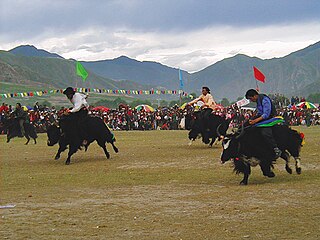
Yak racing is a spectator sport held at many traditional festivals of Tibet, Kazakhstan, Kyrgyzstan, Gilgit-Baltistan, Ladakh and Mongolia, in gatherings which integrate popular dances and songs with traditional physical games. For Tibetans in particular it is a very special festive occasion.

Tourism in Mongolia was extremely limited by the Socialist Government, but has been expanding following the 1990 Democratic Revolution in Mongolia in the wake of the collapse of the USSR and the Revolutions of 1989. Mongolia is a unique and relatively unexplored travel destination that offers a great combination of scenic natural features, a wide variety of untouched landscapes, nomadic life style and culture. Travel organizations in Mongolia date back to half a century ago, but the private sector-based tourism is barely twenty years old. Now Mongolia boasts 403 travel companies, 320 hotels, 647 resorts and tourist camps, all employing the graduates from over 56 educational establishments. Mongolia takes an active part in United Nations World Tourism Organization, of which it is a member party.
Broghil Valley National Park is located in the upper northern reaches of the Upper Chitral District, Khyber Pakhtunkhwa, Pakistan, close to the Afghan-Pakistan border.
Gupis @ Sumpis (Goopechh) Valley is located about 112 kilometers to the west of Gilgit on the bank of River Gilgit, District Ghizer, Gilgit-Baltistan, Pakistan. The Gupis is 2176 meters above sea level. This fort was once used by the military for defence purposes. Later the king (Raja) of the time lived in this fort for several years.
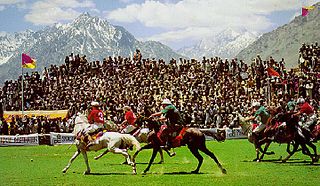
Shandur Polo Festival is a sports festival held annually from 7 to 9 July in the Shandur Top in Pakistan. The polo tournament is played between the teams of Gilgit District and Chitral District, under freestyle rules.
Arkhi is a liquor made from airag, fermented milk brandy, or isgelen tarag which then gets distilled. Isgelen tarag often uses the milk of a mare, donkeys, sheep, cows, the yak, camels (specifically, khormog or of reindeer, depending on local traditions or availability. It holds special status in Mongolia and Inner Mongolia, both as the prime spirit of choice among pastoral units and served to esteemed guests.
Tibet has many traditional games with origins dating up to 5,000 years ago.














